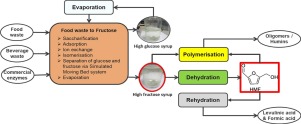Catalysis Today ( IF 5.2 ) Pub Date : 2018-01-09 , DOI: 10.1016/j.cattod.2018.01.011 Iris K.M. Yu , Khai Lun Ong , Daniel C.W. Tsang , Md Ariful Haque , Tsz Him Kwan , Season S. Chen , Kristiadi Uisan , Sandeep Kulkarni , Carol Sze Ki Lin

|
A novel alternative bioconversion and chemical transformation method for valorisation of food and beverage (F&B) waste to hydroxymethylfurfural (HMF) is reported. Solid-to-liquid ratio of 70% was applied to hydrolyse F&B waste by glucoamylase and sucrase to yield a hydrolysate consisted of glucose and fructose. After impurity removal using chromatography columns, the purified hydrolysate was processed by glucose isomerase to produce syrup with a fructose-to-glucose ratio of 1:1. After removal of the residual impurities using ion exchange columns, Simulated Moving Bed system was applied to separate sugars in fructose-glucose syrup. The resultant high-fructose syrup contained 89.0 g/L fructose, which was demonstrated as an ideal feedstock for the synthesis of HMF. By employing a commercial solid acid catalyst (Amberlyst 36), 71 mol% HMF with a high selectivity of 77 mol% was generated from this high-fructose syrup under mild microwave heating at 140 °C within 40 min. The increase in catalyst loading accelerated both HMF formation and HMF-consuming side reactions, underscoring the trade-off between the conversion rate and product selectivity. The solid catalyst can be recovered and successfully reused for four runs with the HMF yield at 70 mol%. An overall conversion yield of 30 g HMF/kg F&B waste was achieved. This work emphasises a novel integration of chemical and biological technologies for selective production of HMF from mixed F&B waste.
中文翻译:

食品和饮料废物中的果糖化学转化为羟甲基糠醛作为增值产品
报道了一种新颖的替代性生物转化和化学转化方法,用于将食品和饮料(F&B)废物估价为羟甲基糠醛(HMF)。固液比为70%,可通过葡糖淀粉酶和蔗糖酶水解食品和饮料废物,以产生由葡萄糖和果糖组成的水解产物。在使用色谱柱去除杂质后,纯化的水解产物通过葡萄糖异构酶进行处理,以产生果糖与葡萄糖的比例为1:1的糖浆。使用离子交换柱去除残留杂质后,将模拟移动床系统应用于分离果糖-葡萄糖浆中的糖。所得的高果糖糖浆包含89.0 g / L的果糖,这被证明是合成HMF的理想原料。通过使用市售的固体酸催化剂(Amberlyst 36),该高果糖糖浆在温和的微波加热下于140°C在40分钟内产生了71 mol%的HMF,具有77 mol%的高选择性。催化剂载量的增加加速了HMF的形成和消耗HMF的副反应,强调了转化率和产物选择性之间的权衡。可以回收固体催化剂并成功地将其再使用四次,HMF收率为70摩尔%。总转化率达到30 g HMF / kg餐饮废弃物。这项工作着重于化学和生物技术的新颖结合,以便从混合的食品和饮料废物中选择性生产HMF。催化剂载量的增加加速了HMF的形成和消耗HMF的副反应,强调了转化率和产物选择性之间的权衡。可以回收固体催化剂并成功地将其再使用四次,HMF收率为70摩尔%。总转化产量为30 g HMF / kg餐饮废物。这项工作着重于化学和生物技术的新颖结合,以便从混合的食品和饮料废物中选择性生产HMF。催化剂载量的增加加速了HMF的形成和消耗HMF的副反应,强调了转化率和产物选择性之间的权衡。可以回收固体催化剂并成功地将其再使用四次,HMF收率为70摩尔%。总转化产量为30 g HMF / kg餐饮废物。这项工作着重于化学和生物技术的新颖结合,以便从混合的食品和饮料废物中选择性生产HMF。











































 京公网安备 11010802027423号
京公网安备 11010802027423号